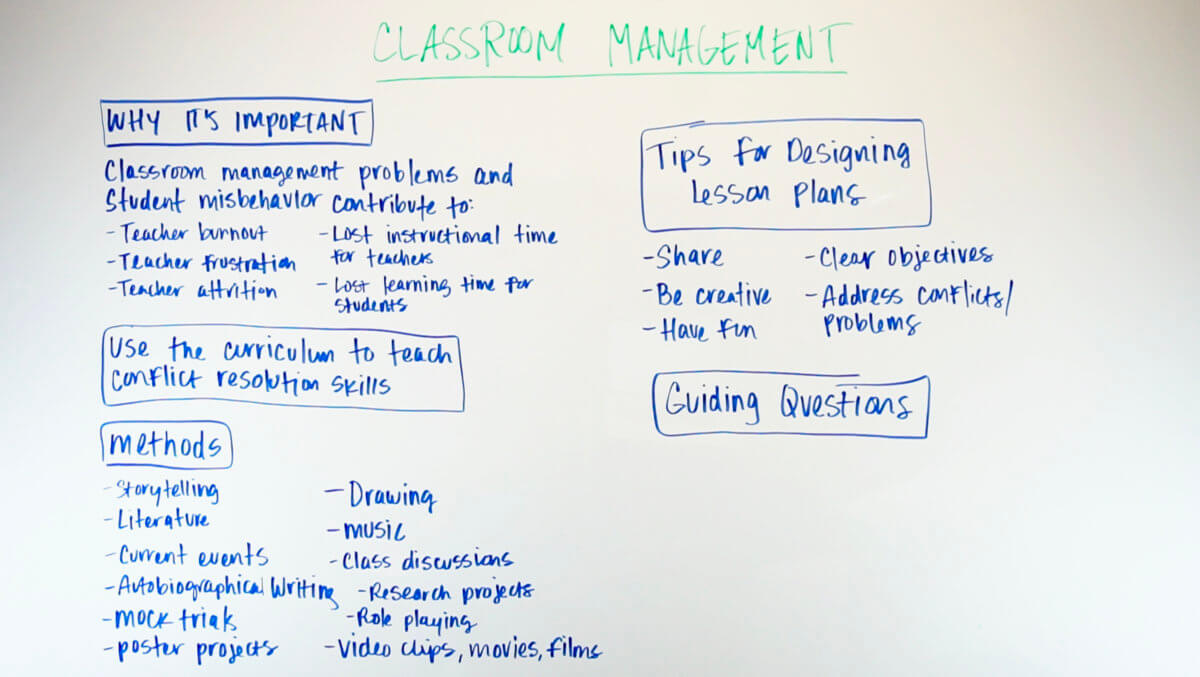Classroom Management Tips and Tricks
https://youtu.be/sQWHaOa0DaI
Presented by Dr. Gail Thompson – Transcription Below
Introduction
Hello, everyone. Welcome to the Illuminate Whiteboard Series. I’m Dr. Gail Thompson. And I am the equity and professional development expert at Illuminate Education. I’m also an author and researcher.
Classroom Management
Today, I’d like to talk to you about classroom management. During my travels conducting professional development workshops, I hear a lot of teachers and school leaders complain about student misbehavior. And we know that classroom management problems and student misbehavior contribute to teacher burnout, teacher frustration, teacher attrition, lost instructional time for teachers, and lost learning time for students.
Handling Student Misbehavior
When I was a teacher, for 14 years, I also had my share of classroom management problems. During that time, I made a lot of mistakes, but I also learned some important lessons about student misbehavior, classroom management and effective instruction, because the three are tied together. I shared this information during the professional development workshops that I conduct. But one of the main lessons that I’ve learned which I want to share with you today is that a lot of students get into trouble at school because they don’t know how to handle conflicts in ways that will keep them in the classroom and out of the principal’s office.
Simple Strategies to Help
So today, I want to share a very simple strategy that you can use in order to keep students in the classroom and out of the principal’s office, and thereby, out of the school-to-prison pipeline. You can use the curriculum to teach conflict resolution skills. I did this. I had a lot of fun doing this, and it was a way to increase student engagement and student interest and to make that curriculum interesting and relevant. So when you talk about culturally-responsive teaching, here’s a great way of doing that. And that is using storytelling, using literature, using current events, and you see the list here. Autobiographies, mock trials, drawing, music, class discussions, research projects, role-playing, poster projects, video clips, movies, you name it, you can use these and other instructional tools to teach conflict resolution skills.
Lesson Plans to Handle Conflict
Here are some tips for designing lesson plans that can help students learn how to handle conflicts in ways that will keep them in the classroom and out of the principal’s office. First of all, as an educator, share your stories of how you have handled conflicts in the past. Be creative and have fun as you’re designing lesson plans. Make your objectives very clear and they should be tied to standards. Try to address some of the most common types of conflicts or problems that your students may face. Make sure that each lesson plan gives students opportunities to share their viewpoints and their experiences in handling conflicts. Make sure they have lots of opportunities to hear your viewpoint about the topic and the viewpoints and experiences of their classmates.
Personalize Student Conflict Resolution
You can have students create, decorate, and keep a personalized conflict resolution folder or journal, so that they’re adding new strategies on an ongoing basis. And then include guiding questions such as the following guiding questions in your lesson plans. If you were the main character or the individual, how do you think you would have felt if you were experiencing this problem? In your opinion, did the individual handle the problem in the best way? Why or why not? If you were the individual, how would you have handled the problem and what would have been the consequences of your decision?
Guiding Questions
You really want to talk a lot about fighting and arguing, so here’s a related guiding question. What are some of the consequences of fist-fighting to resolve conflicts or using violence to solve conflicts? When you are upset with someone, what are some alternatives to fighting or arguing? How can you tell when someone is giving you good advice or bad advice about how to handle a problem? And how can knowing how to handle conflicts wisely increase your chances of having a good life?
In Conclusion
So let me conclude by reminding you that each time you choose to share or have students read or view a story about resiliency or how to handle a conflict wisely, you are increasing their chances of staying out of the prison pipeline and staying in that classroom and learning some empowering life lessons.
Thank you for your time. I hope to see you soon.
Whiteboard Image –

Audio Only –
*****
Illuminate Education is a provider of educational technology and services offering innovative data, assessment and student information solutions. Serving K-12 schools, our cloud-based software and services currently assist more than 1,600 school districts in promoting student achievement and success.
Ready to discover your one-stop shop for your district’s educational needs? Let’s talk.

